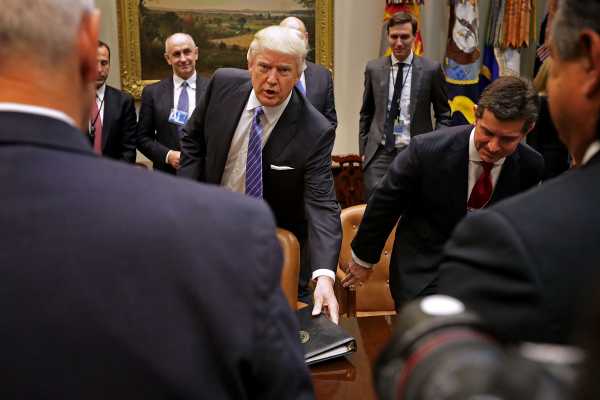
White House staff secretary Rob Porter’s resignation over domestic violence accusations, followed by speechwriter David Sorensen’s a few days later, has thrown the West Wing into chaos and endangered Chief of Staff John Kelly’s job.
But the White House’s staffing crisis runs deeper. The Washington Post counts 37 high-level Trump aides or advisers who’ve resigned or been fired, including a chief of staff, multiple agency heads, and — importantly, given the administration’s need to build a bench for its future — deputy directors of the National Economic Council, the National Security Council, and the Domestic Policy Council, as well as multiple deputy chiefs of staff. Many of these jobs remain open today. Many more resignations are expected.
“The biggest threat to the Trump presidency, the markets and our ability to deal with future crises is the coming staff exodus,” wrote Washington insider Mike Allen in October.
That exodus is upon us.
Discussions with people who work in the Trump administration, or work closely with the Trump administration, make clear that the core of the staffing crisis is a management crisis. Working in this White House is a frustrating, dispiriting, and often surreal experience, and it exposes staffers to both legal and reputational risks. Insiders tend to trace three zones of dysfunction, all of which overlap, and all of which destabilize daily functioning and, in turn, scare off potential recruits.
Incoherence, infighting, and inexperience
1) Trump’s volatility creates fear, confusion, and frustration. The first and most important zone of dysfunction surrounds Trump himself: No one knows quite what he will do or say or want, and so staffers spend their days working on deals and plans that they know could be wrecked by a tweet or a late-night phone call or something the president saw on Fox & Friends.
Trump is also a difficult and disloyal boss who doesn’t listen when you brief him, doesn’t read the documents you prepare for him, and can’t correctly remember what you’ve told him. And if you anger him, he will turn on you in a meeting or, worse, in public. No one wants to end up like Steve Bannon or Jeff Sessions. And none of this is a secret to the men and women who might be next in line for these jobs.
2) Incoherence at the top leads to constant infighting below. Trump is uninterested in core questions of governance, has never resolved the ideological tensions in his administration, and is heavily influenced by whoever gets to him last. The result is an ongoing battle, which plays out through both bureaucratic maneuvering and constant leaking, between the various ideological factions of the administration. These fights often seem catty and personal when they spill out into the press, but the stakes are nothing less than the direction of America’s domestic and foreign policy.
This makes the Trump White House a particularly dangerous place to work. All of the factions are constantly maneuvering to consolidate or regain influence by deposing members of rival factions. If you’ve noticed a lot of knives out for Kelly in the aftermath of Porter’s resignation, this is partly why: Kelly tightly controls access to Trump and is personally pushing Trump toward a hard line on immigration, and so White House staff who don’t want Trump to take such a hard line on immigration or who just want more access to Trump are using Kelly’s mishandling of Porter to weaken or oust him.
In another administration, this wouldn’t be as potent a strategy. Driving Denis McDonough out of Barack Obama’s White House, or Josh Bolten out of George W. Bush’s White House, would not have fundamentally changed the ideology of either administration because both administrations were run by presidents who knew what they believed and who hired chiefs of staff to enforce their will. But Trump’s views are so mutable, and he’s so deeply swayed by whoever gets into his office or onto his call list, that replacing Kelly with someone else could actually lead to a different version of the Trump administration — it’s likely, for instance, that Chief of Staff Gary Cohn would have pushed Trump toward a deal on DREAMers, rather than away from one.
Trump has set up an administration where the direction of policy is up for grabs and the possible payoffs to deposing colleagues are huge. The results have been roughly as you’d expect.
3) Early staffing decisions have led to ongoing scandals and legal risks. The third zone of dysfunction is the Trump administration’s haphazard staffing and vetting procedures. In a normal administration, Porter would have left quietly when it came clear that his record of domestic violence disqualified him for a full security clearance; instead, the Trump White House kept him on, only to have his past erupt into scandal.



Similarly, the Trump White House is mired in investigations circling the activities of Trump’s motley, amateurish campaign crew — Donald Trump Jr. and Carter Page and George Papadopoulos and Michael Flynn and Jared Kushner would have been nowhere near the center of a normal presidential operation — and those investigations are discouraging new staffers from joining the administration because they don’t want the hefty legal fees of getting caught in the Russia investigation or whatever scandal may erupt next.
During the campaign, Trump repeatedly promised to “hire the best people.” But the best people want to work for the best bosses, in the best organizations, supported by the best cultures. Trump hasn’t created anything of the kind. The Trump administration is a leaky, chaotic, dangerous place, where staffers operate under constant threat from Trump and each other, and in which the president is so uncertain of his own opinions and agenda that more staff energy goes into persuading him of what he believes than carrying out what he wants.
A year into his presidency, the bar for Trump administration staffing has been lowered. Forget the best people. It’s an open question whether he can even attract qualified people. But that’s because this isn’t really a crisis of staffing. It’s a crisis of management.
Sourse: vox.com






